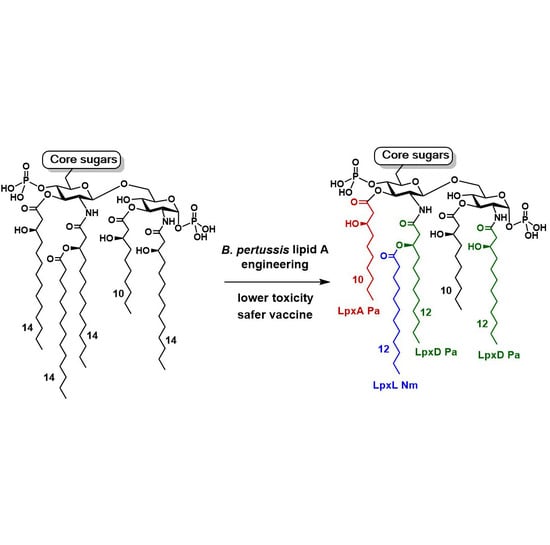Shortening the Lipid A Acyl Chains of Bordetella pertussis Enables Depletion of Lipopolysaccharide Endotoxic Activity
Abstract
1. Introduction
2. Material and Methods
2.1. Plasmids, Strains, and Growth Conditions
2.2. Genetic Manipulations
2.3. RNA Extraction and Reverse Transcriptase (RT)-PCR
2.4. Electrophoresis and Western Blotting
2.5. LPS Purification and Analysis
2.6. Eukaryotic Cell Lines and TLR4 Signalling
2.7. Animal Experiments
2.8. Statistical Analysis
3. Results
3.1. Production of Heterologous Lpx Enzymes in B. pertussis
3.2. Analysis of Recombinant Lipid A Structures
3.3. Differential Activation of TLR4 by the LPS Variants
3.4. Construction of Stable LPS Mutants in a Vaccine Strain
3.5. LPS-induced Pyrogenicity Response in Rabbits
4. Discussion
5. Conclusions
6. Patents
Supplementary Materials
Author Contributions
Funding
Acknowledgments
Conflicts of Interest
References
- Dewan, K.K.; Linz, B.; DeRocco, S.E.; Harvill, E.T. Acellular Pertussis Vaccine Components: Today and Tomorrow. Vaccines 2020, 8, 217. [Google Scholar] [CrossRef] [PubMed]
- Fullen, A.R.; Yount, K.S.; Dubey, P.; Deora, R. Whoop! There it is: The surprising resurgence of pertussis. PLoS. Pathog. 2020, 16, e1008625. [Google Scholar] [CrossRef]
- Burdin, N.; Handy, L.K.; Plotkin, S.A. What is wrong with pertussis vaccine immunity? The problem of waning effectiveness of pertussis vaccines. Cold Spring Harb. Perspect. Biol. 2017, 9, a029454. [Google Scholar] [CrossRef]
- Warfel, J.M.; Zimmerman, L.I.; Merkel, T.J. Acellular pertussis vaccines protect against disease but fail to prevent infection and transmission in a nonhuman primate model. Proc. Natl. Acad. Sci. USA 2014, 111, 787–792. [Google Scholar] [CrossRef]
- Gill, C.; Rohani, P.; Thea, D.M. The relationship between mucosal immunity, nasopharyngeal carriage, asymptomatic transmission and the resurgence of Bordetella pertussis. F1000Res 2017, 25, 1568. [Google Scholar] [CrossRef] [PubMed]
- Ring, N.; Abrahams, J.S.; Bagby, S.; Preston, A.; MacArthur, I. How Genomics Is Changing What We Know About the Evolution and Genome of Bordetella pertussis. Adv. Exp. Med. Biol. 2019, 1183, 1–17. [Google Scholar] [PubMed]
- Carbonetti, N.H. Bordetella pertussis: New concepts in pathogenesis and treatment. Curr. Opin. Infect. Dis. 2016, 29, 287–294. [Google Scholar] [CrossRef]
- Geurtsen, J.; Steeghs, L.; Hamstra, H.J.; ten Hove, J.; de Haan, A.; Kuipers, B.; Tommassen, J.; van der Ley, P. Expression of the lipopolysaccharide-modifying enzymes PagP and PagL modulates the endotoxic activity of Bordetella pertussis. Infect. Immun. 2006, 74, 5574–5585. [Google Scholar] [CrossRef] [PubMed]
- Peppler, M.S. Two physically and serologically distinct lipopolysaccharide profiles in strains of Bordetella pertussis and their phenotype variants. Infect. Immun. 1984, 43, 224–232. [Google Scholar] [CrossRef]
- Raetz, C.R.H.; Whitfield, C. Lipopolysaccharide endotoxins. Annu. Rev. Biochem. 2002, 71, 635–700. [Google Scholar] [CrossRef]
- Rietschel, E.T.; Schade, U.; Jensen, M.; Wollenweber, H.W.; Lüderitz, O.; Greisman, S.G. Bacterial endotoxins: Chemical structure, biological activity and role in septicaemia. Scand. J. Infect. Dis. Suppl. 1982, 31, 8–21. [Google Scholar] [PubMed]
- Palsson-McDermott, E.M.; O’Neill, L.A. Signal transduction by the lipopolysaccharide receptor, Toll-like receptor-4. Immunology 2004, 113, 153–162. [Google Scholar] [CrossRef] [PubMed]
- Alexander, C.; Rietschel, E.T. Bacterial lipopolysaccharides and innate immunity. J. Endotoxin. Res. 2001, 7, 167–202. [Google Scholar] [CrossRef] [PubMed]
- Conti, P.; Dempsey, R.A.; Reale, M.; Barbacane, R.C.; Panara, M.R.; Bongrazio, M.; Mier, J.W. Activation of human natural killer cells by lipopolysaccharide and generation of interleukin-1 alpha, beta, tumour necrosis factor and interleukin-6. Effect of IL-1 receptor antagonist. Immunology 1991, 73, 450–456. [Google Scholar] [PubMed]
- Cinel, I.; Dellinger, R.P. Advances in pathogenesis and management of sepsis. Curr. Opin. Infect. Dis. 2007, 20, 345–352. [Google Scholar] [CrossRef]
- Crowell, D.N.; Anderson, M.S.; Raetz, C.R.H. Molecular cloning of the genes for lipid A disaccharide synthase and UDP-N-acetylglucosamine acyltransferase in Escherichia coli. J. Bacteriol. 1986, 168, 152–159. [Google Scholar] [CrossRef]
- Coleman, J.; Raetz, C.R.H. First committed step of lipid A biosynthesis in Escherichia coli: Sequence of the lpxA gene. J. Bacteriol. 1988, 170, 1268–1274. [Google Scholar] [CrossRef]
- Maeshima, N.; Fernandez, C.R. Recognition of lipid A variants by the TLR4-MD-2 receptor complex. Front. Cell. Infect. Microbiol. 2013, 3, 3. [Google Scholar] [CrossRef]
- Steeghs, L.; Berns, M.; ten Hove, J.; de Jong, A.; Roholl, P.; van Alphen, L.; Tommassen, J.; van der Ley, P. Expression of foreign LpxA acyltransferases in Neisseria meningitidis results in modified lipid A with reduced toxicity and retained adjuvant activity. Cell. Microbiol. 2002, 4, 599–611. [Google Scholar] [CrossRef]
- Needham, B.D.; Carroll, S.M.; Giles, D.K.; Georgiou, G.; Whiteley, M.; Trent, M.S. Modulating the innate immune response by combinatorial engineering of endotoxin. Proc. Natl. Acad. Sci. USA 2013, 110, 1464–1469. [Google Scholar] [CrossRef]
- Wyckoff, T.J.; Lin, S.; Cotter, R.J.; Dotson, G.D.; Raetz, C.R.H. Hydrocarbon rulers in UDP-N-acetylglucosamine acyltransferases. J. Biol. Chem. 1998, 273, 32369–32372. [Google Scholar] [CrossRef] [PubMed]
- Bartling, C.M.; Raetz, C.R.H. Crystal structure and acyl chain selectivity of Escherichia coli LpxD, the N-acyltransferase of lipid A biosynthesis. Biochemistry 2009, 48, 8672–8683. [Google Scholar] [CrossRef] [PubMed][Green Version]
- Raetz, C.R.H.; Reynolds, C.M.; Trent, M.S.; Bishop, R.E. Lipid A modification systems in gram-negative bacteria. Annu. Rev. Biochem. 2007, 76, 295–329. [Google Scholar] [CrossRef] [PubMed]
- Zariri, A.; van der Ley, P. Biosynthetically engineered lipopolysaccharide as vaccine adjuvant. Expert. Rev. Vaccines. 2015, 14, 861–876. [Google Scholar] [CrossRef] [PubMed]
- Arenas, J. The role of bacterial lipopolysaccharides as immune modulator in vaccine and drug development. Endocr. Metab. Immune Disord. Drug. Targets. 2012, 12, 221–235. [Google Scholar] [CrossRef]
- Arenas, J.; Pupo, E.; de Jonge, E.; Pérez-Ortega, J.; Schaarschmidt, J.; van der Ley, P.; Tommassen, J. Substrate specificity of the pyrophosphohydrolase LpxH determines the asymmetry of Bordetella pertussis lipid A. J. Biol. Chem. 2019, 294, 7982–7989. [Google Scholar] [CrossRef] [PubMed]
- Kasuga, T.; Nakase, Y.; Ukishima, K.; Takatsu, K. Studies on Haemophilus pertussis. Kitasato Arch. Exp. Med. 1954, 27, 57–62. [Google Scholar]
- Bart, M.J.; Zeddeman, A.; van der Heide, H.G.J.; Heuvelman, K.; van Gent, M.; Mooi, F.R. Complete genome sequences of Bordetella pertussis isolates B1917 and B1920, representing two predominant global lineages. Genome. Announc. 2014, 2, e01301. [Google Scholar] [CrossRef]
- Verwey, W.F.; Thiele, E.H.; Sage, D.N.; Schuchardt, L.F. A simplified liquid culture medium for the growth of Hemophilus pertussis. J. Bacteriol. 1949, 58, 127–134. [Google Scholar] [CrossRef]
- Fürste, J.P.; Pansegrau, W.; Frank, R.; Blöcker, H.; Scholz, P.; Bagdasarian, M.; Lanka, E. Molecular cloning of the plasmid RP4 primase region in a multi-host-range tacP expression vector. Gene 1986, 48, 119–131. [Google Scholar] [CrossRef]
- Skorupski, K.; Taylor, R.K. Positive selection vectors for allelic exchange. Gene 1996, 169, 47–52. [Google Scholar] [CrossRef]
- Stibitz, S. Use of conditionally counterselectable suicide vectors for allelic exchange. Meth. Enzymol. 1994, 235, 458–465. [Google Scholar] [PubMed]
- Miller, V.L.; Mekalanos, J.J. A novel suicide vector and its use in construction of insertion mutations: Osmoregulation of outer membrane proteins and virulence determinants in Vibrio cholerae requires toxR. J. Bacteriol. 1988, 170, 2575–2583. [Google Scholar] [CrossRef] [PubMed]
- Arenas, J.; Paganelli, F.L.; Rodríguez-Castaño, P.; Cano-Crespo, S.; van der Ende, A.; van Putten, J.P.M.; Tommassen, J. Expression of the gene for autotransporter AutB of Neisseria meningitidis affects biofilm formation and epithelial transmigration. Front. Cell. Infect. Microbiol. 2016, 6, 162. [Google Scholar] [CrossRef] [PubMed]
- Arenas, J.; Cano, S.; Nijland, R.; van Dongen, V.; Rutten, L.; van der Ende, A.; Tommassen, J. The meningococcal autotransporter AutA is implicated in autoaggregation and biofilm formation. Environ. Microbiol. 2015, 17, 1321–1337. [Google Scholar] [CrossRef] [PubMed]
- Westphal, O.; Jann, K. Bacterial lipopolysaccharides extraction with phenol-water and further applications of the procedure. Meth. Carboh. Chem. 1965, 5, 83–91. [Google Scholar]
- Caroff, M.; Brisson, J.; Martin, A.; Karibian, D. Structure of the Bordetella pertussis 1414 endotoxin. FEBS Lett. 2000, 477, 8–14. [Google Scholar] [CrossRef]
- Geurtsen, J.; Angevaare, E.; Janssen, M.; Hamstra, H.J.; ten Hove, J.; de Haan, A.; Kuipers, B.; Tommassen, J.; van der Ley, P. A novel secondary acyl chain in the lipopolysaccharide of Bordetella pertussis required for efficient infection of human macrophages. J. Biol. Chem. 2007, 282, 37875–37884. [Google Scholar] [CrossRef]
- Vaure, C.; Yuanqing, L. A comparative review of toll-like receptor 4 expression and functionality in different animal species. Front. Immunol. 2014, 10, 316. [Google Scholar] [CrossRef]
- Stöver, A.G.; Da Silva, C.J.; Evans, J.T.; Cluff, C.W.; Elliott, M.W.; Jeffery, E.W.; Johnson, D.A.; Lacy, M.J.; Baldridge, J.R.; Probst, P.; et al. Structure-activity relationship of synthetic toll-like receptor 4 agonists. J. Biol. Chem. 2004, 279, 4440–4449. [Google Scholar] [CrossRef]
- Marr, N.; Novikov, A.; Hajjar, A.M.; Caroff, M.; Fernandez, R.C. Variability in the lipooligosaccharide structure and endotoxicity among Bordetella pertussis strains. J. Infect. Dis. 2010, 202, 1897–1906. [Google Scholar] [CrossRef]
- Brummelman, J.; Veerman, R.E.; Hamstra, H.J.; Deuss, A.J.; Schuijt, T.J.; Sloots, A.; Kuipers, B.; van Els, C.A.C.M.; van der Ley, P.; Mooi, F.R.; et al. Bordetella pertussis naturally occurring isolates with altered lipooligosaccharide structure fail to fully mature human dendritic cells. Infect. Immun. 2015, 83, 227–238. [Google Scholar] [CrossRef]
- Shah, N.R.; Albitar-Nehme, S.; Kim, E.; Marr, N.; Novikov, A.; Caroff, M.; Fernandez, R.C. Minor modifications to the phosphate groups and the C3’ acyl chain length of lipid A in two Bordetella pertussis strains, BP338 and 18–323, independently affect Toll-like receptor 4 protein activation. J. Biol. Chem. 2013, 288, 11751–11760. [Google Scholar] [CrossRef]
- Park, B.S.; Lee, J.O. Recognition of lipopolysaccharide pattern by TLR4 complexes. Exp. Mol. Med. 2013, 45, e66. [Google Scholar] [CrossRef]
- Park, B.S.; Song, D.H.; Kim, H.M.; Choi, B.S.; Lee, H.; Lee, J.O. The structural basis of lipopolysaccharide recognition by the TLR4-MD-2 complex. Nature 2009, 458, 1191–1195. [Google Scholar] [CrossRef]
- Ohto, U.; Fukase, K.; Miyake, K.; Satow, Y. Crystal structures of human MD-2 and its complex with antiendotoxic lipid IVa. Science 2007, 316, 1632–1634. [Google Scholar] [CrossRef]
- Kim, H.M.; Park, B.S.; Kim, J.I.; Kim, S.E.; Lee, J.; Oh, S.C.; Enkhbayar, P.; Matsushima, N.; Lee, H.; Yoo, O.J.; et al. Crystal structure of the TLR4-MD-2 complex with bound endotoxin antagonist Eritoran. Cell 2007, 130, 906–917. [Google Scholar] [CrossRef]
- Garate, J.A.; Stöckl, J.; del Carmen Fernández-Alonso, M.; Artner, D.; Haegman, M.; Oostenbrink, C.; Jimènez-Barbero, J.; Beyaert, R.; Heine, H.; Kosma, P.; et al. Anti-endotoxic activity and structural basis for human MD-2·TLR4 antagonism of tetraacylated lipid A mimetics based on βGlcN(1<->1)αGlcN scaffold. Innate Immun. 2015, 21, 490–503. [Google Scholar] [CrossRef]
- Artner, D.; Oblak, A.; Ittig, S.; Garate, J.A.; Horvat, S.; Arrieumerlou, C.; Hofinger, A.; Oostenbrink, C.; Jerala, R.; Kosma, P.; et al. Conformationally constrained Lipid A mimetics for exploration of structural basis of TLR4/MD-2 activation by lipopolysaccharide. ACS. Chem. Biol. 2013, 8, 2423–2432. [Google Scholar] [CrossRef]
- Adanitsch, F.; Ittig, S.; Stöckl, J.; Oblak, A.; Haegman, M.; Jerala, R.; Beyaert, R.; Kosma, P.; Zamyatina, A. Development of αGlcN(1<->1)αMan-based Lipid A mimetics as a novel class of potent Toll-like Receptor 4 agonists. J. Med. Chem. 2014, 57, 8056–8071. [Google Scholar] [CrossRef]
- Paramo, T.; Piggot, T.J.; Bryant, C.E.; Bond, P.J. The structural basis for Endotoxin-induced allosteric regulation of the Toll-Like Receptor 4 (TLR4) innate immune receptor. J. Biol. Chem. 2013, 288, 36215–36225. [Google Scholar] [CrossRef]
- Bryant, C.E.; Spring, D.R.; Gangloff, M.; Gay, N.J. The molecular basis of the host response to lipopolysaccharide. Nat. Rev. Microbiol. 2010, 8, 8–14. [Google Scholar] [CrossRef]
- Yu, L.; Phillips, R.L.; Zhang, D.; Teghanemt, A.; Weiss, J.P.; Gioannini, T.L. NMR studies of hexaacylated endotoxin bound to wild-type and F126A mutant MD-2 and MD-2-TLR4 ectodomain complexes. J. Biol. Chem. 2012, 287, 16346–16355. [Google Scholar] [CrossRef]
- Ohto, U.; Fukase, K.; Miyake, K.; Shimizu, T. Structural basis of species-specific endotoxin sensing by innate immune receptor TLR4/MD-2. Proc. Natl. Acad. Sci. USA 2012, 109, 7421–7426. [Google Scholar] [CrossRef]
- Needham, B.D.; Trent, M.S. Fortifying the barrier: The impact of lipid A remodelling on bacterial pathogenesis. Nat. Rev. Microbiol. 2013, 11, 467–481. [Google Scholar] [CrossRef]
- Teghanemt, A.; Zhang, D.; Levis, E.N.; Weiss, J.P.; Gioannini, T.L. Molecular basis of reduced potency of underacylated endotoxins. J. Immunol. 2005, 175, 4669–4676. [Google Scholar] [CrossRef]
- Zähringer, U.; Ittig, S.; Lindner, B.; Moll, H.; Schombel, U.; Gisch, N.; Cornelis, G.R. NMR-based structural snalysis of the complete rough-type lipopolysaccharide isolated from Capnocytophaga canimorsus. J. Biol. Chem. 2014, 289, 23963–23976. [Google Scholar] [CrossRef]
- Raetz, C.R.H.; Garrett, T.A.; Reynolds, C.M.; Shaw, W.A.; Moore, J.D.; Smith, D.C.J.; Ribeiro, A.A.; Murphy, R.C.; Ulevitch, R.J.; Fearns, C.; et al. Kdo2-Lipid A of E. coli, a defined endotoxin that activates macrophages via TLR-4. J. Lipid. Res. 2006, 47, 1097–1111. [Google Scholar] [CrossRef]
- Akashi, S.; Nagai, Y.; Ogata, H.; Oikawa, M.; Fukase, K.; Kusumoto, S.; Kawasaki, K.; Nishijima, M.; Hayashi, S.; Kimoto, M.; et al. Human MD-2 confers on mouse Toll-like receptor 4 species-specific lipopolysaccharide recognition. Int. Immunol. 2001, 13, 1595–1599. [Google Scholar] [CrossRef]
- Walsh, C.; Gangloff, M.; Monie, T.; Smyth, T.; Wei, B.; McKinley, T.J.; Maskell, D.; Gay, N.; Bryant, C. Elucidation of the MD-2/TLR4 interface required for signaling by lipid IVa. J. Immunol. 2008, 181, 1245–1254. [Google Scholar] [CrossRef] [PubMed]
- Steeghs, L.; Keestra, A.M.; van Mourik, A.; Uronen-Hansson, H.; van der Ley, P.; Callard, R.; Klein, N.; van Putten, J.P.M. Differential activation of human and mouse Toll-like receptor 4 by the adjuvant candidate LpxL1 of Neisseria meningitidis. Infect. Immun. 2008, 76, 3801–3807. [Google Scholar] [CrossRef]
- Raeven, R.H.N.; Rockx-Brouwer, D.; Kanojia, G.; van der Maas, L.; Bindels, T.H.E.; Ten Have, R.; van Riet, R.; Metz, B.; Kersten, G.F.A. Intranasal immunization with outer membrane vesicle pertussis vaccine confers broad protection through mucosal IgA and Th17 responses. Sci. Rep. 2020, 30, 7396. [Google Scholar]
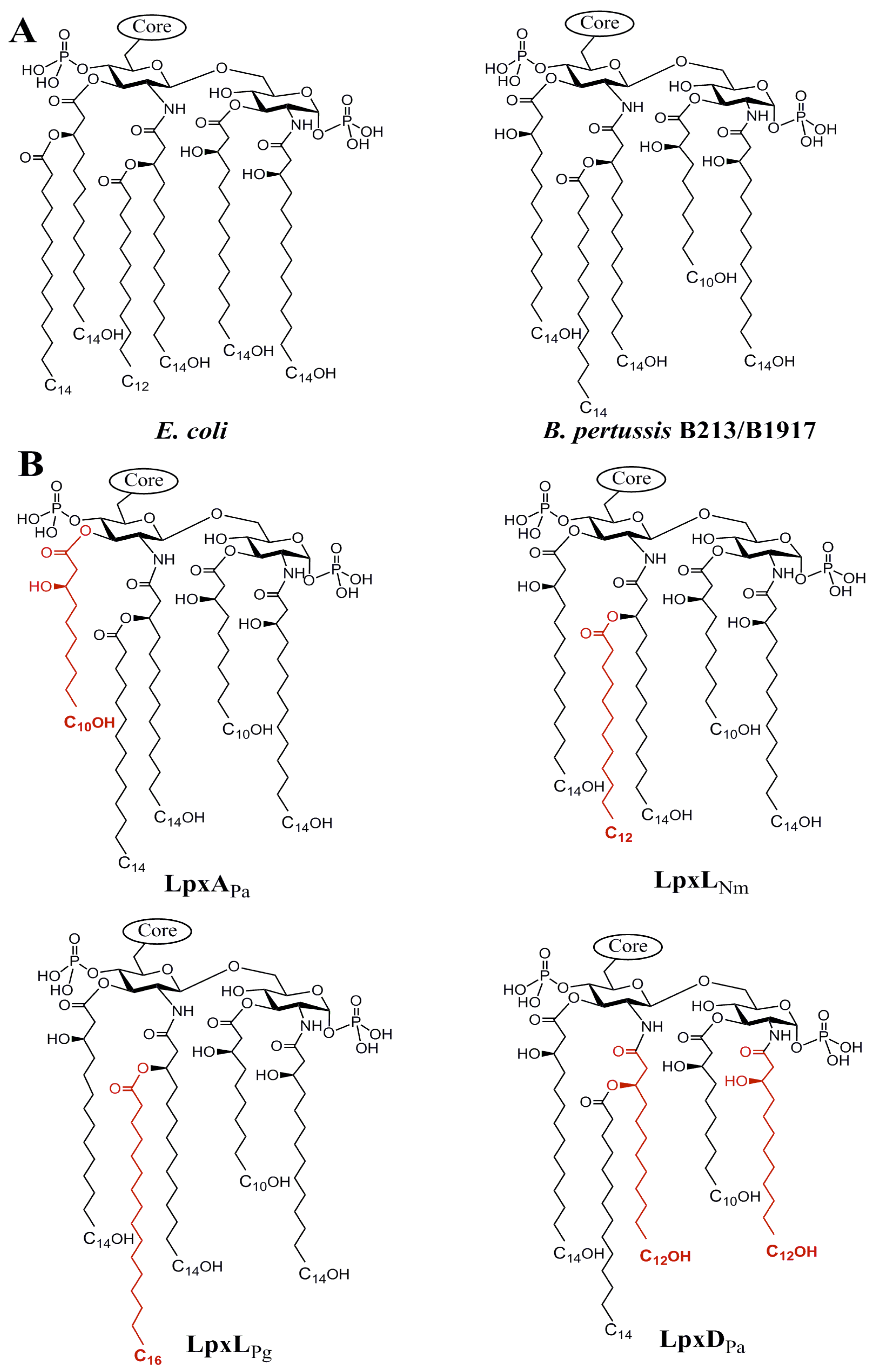
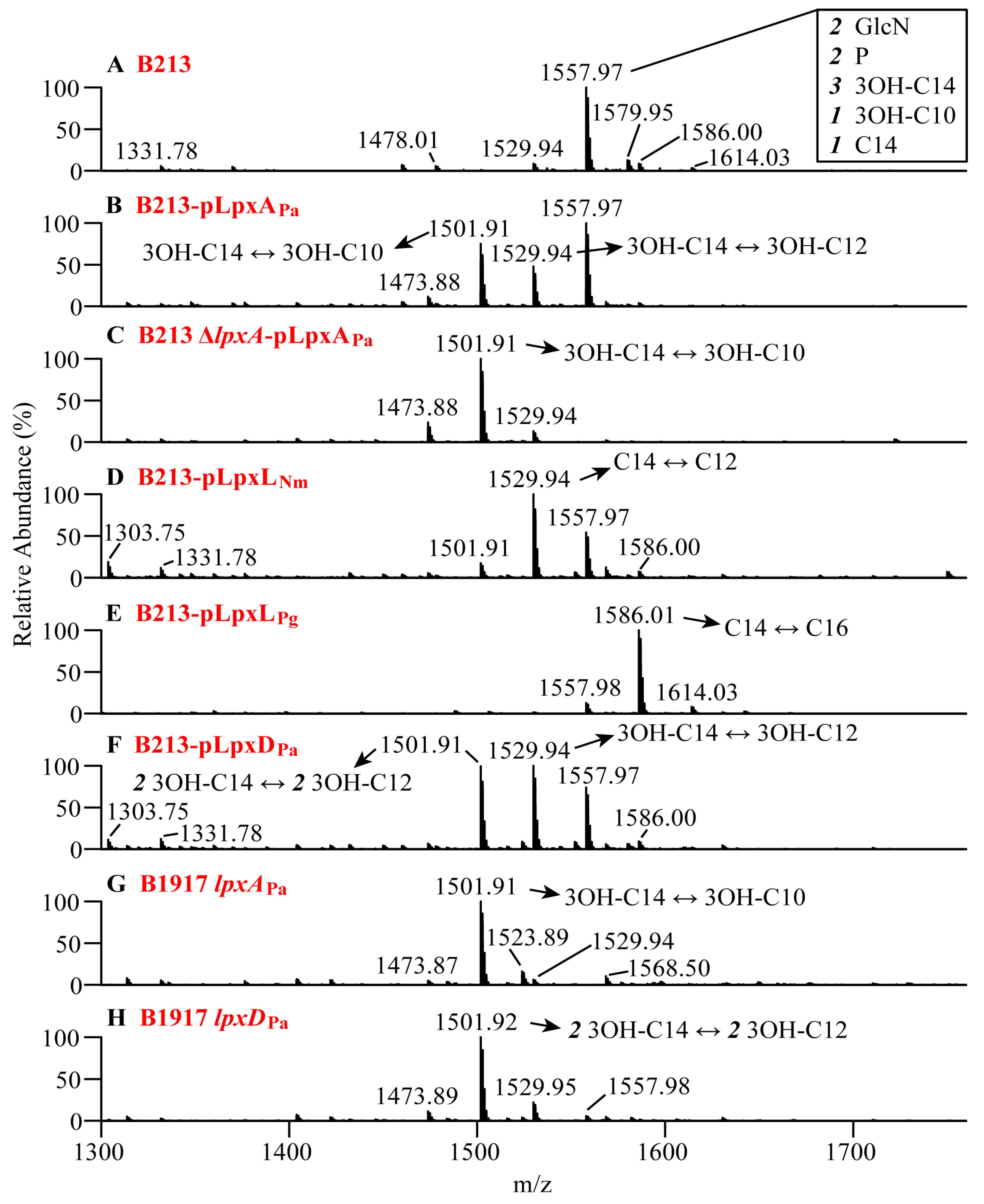
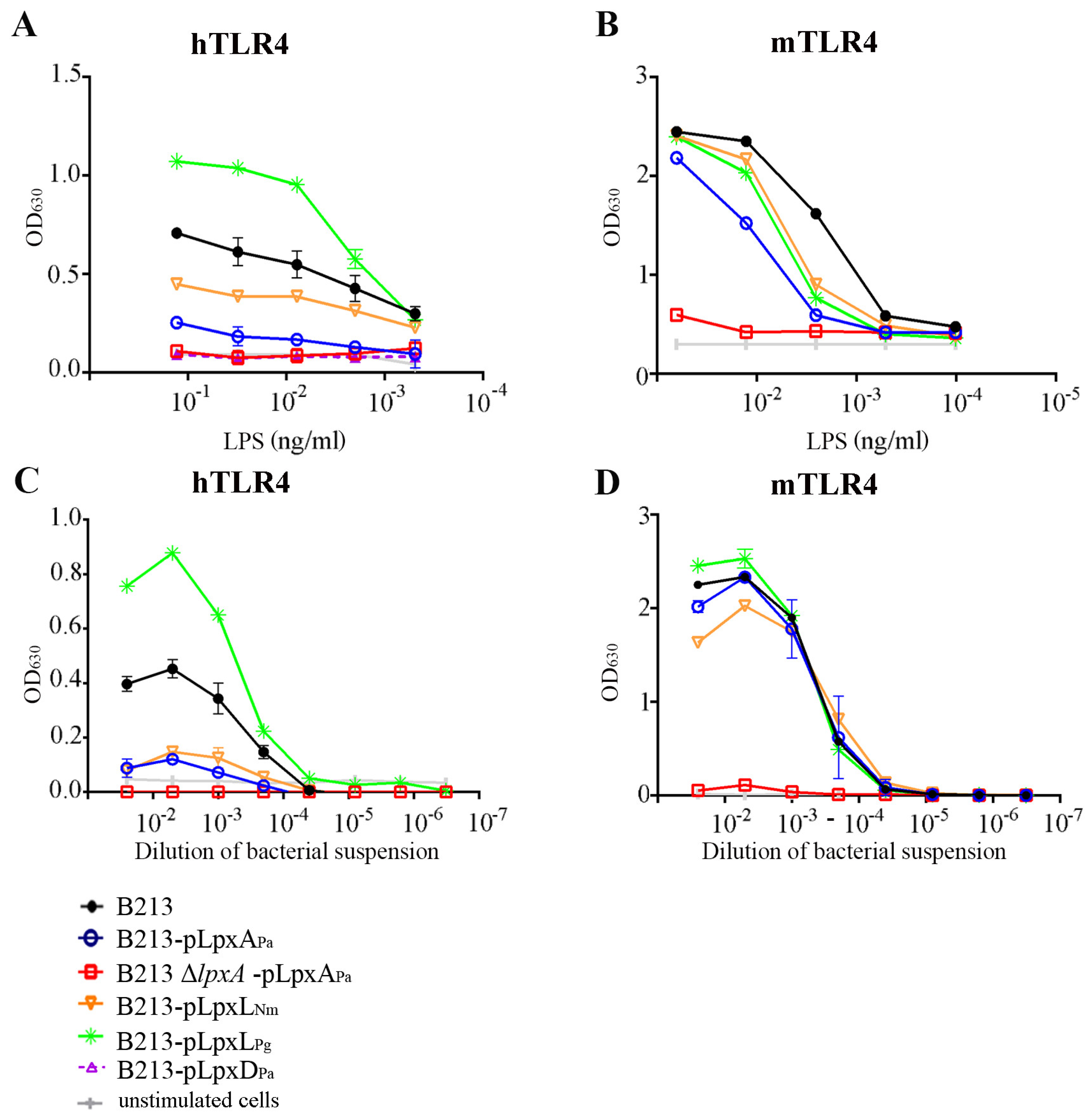
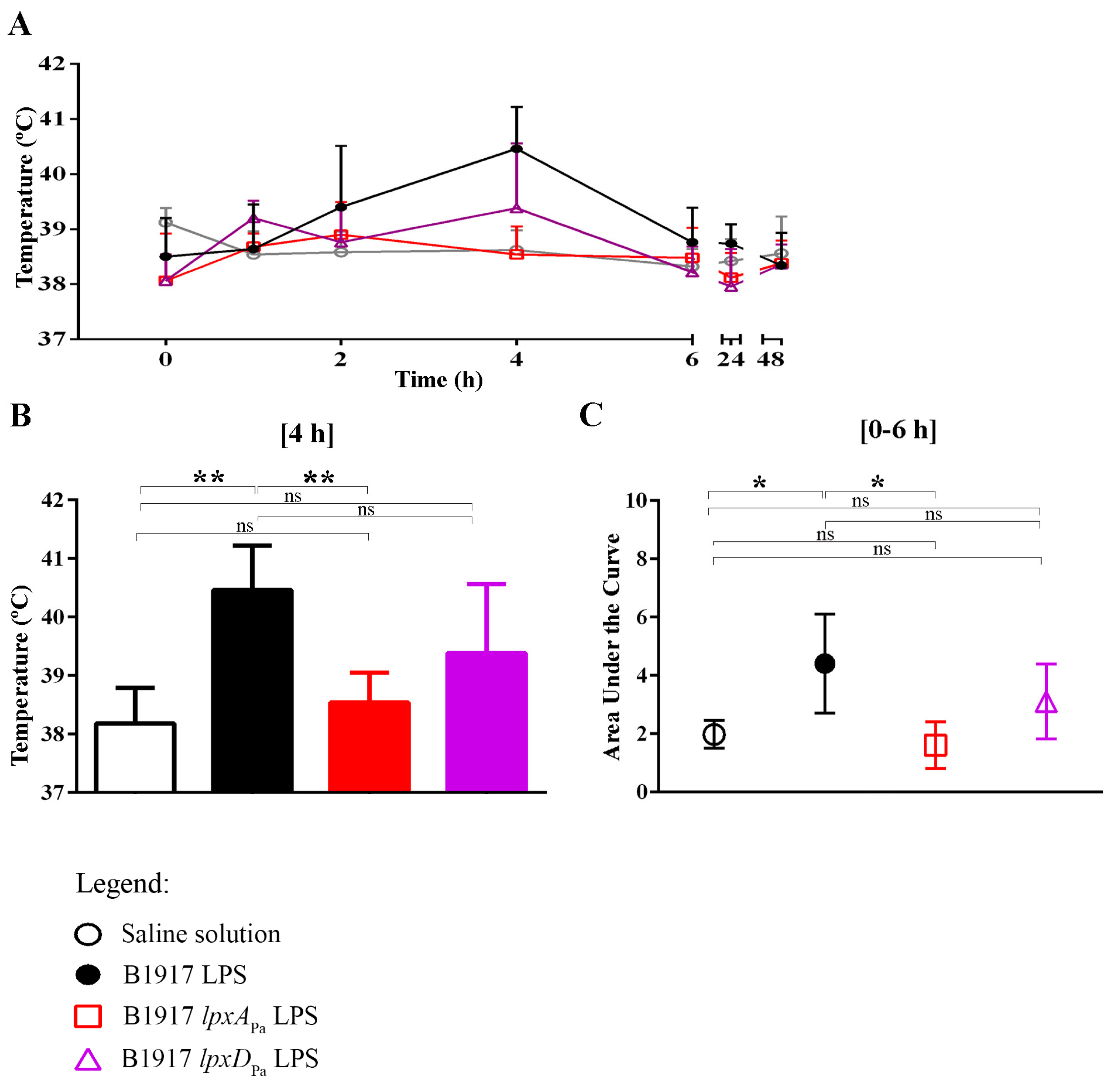
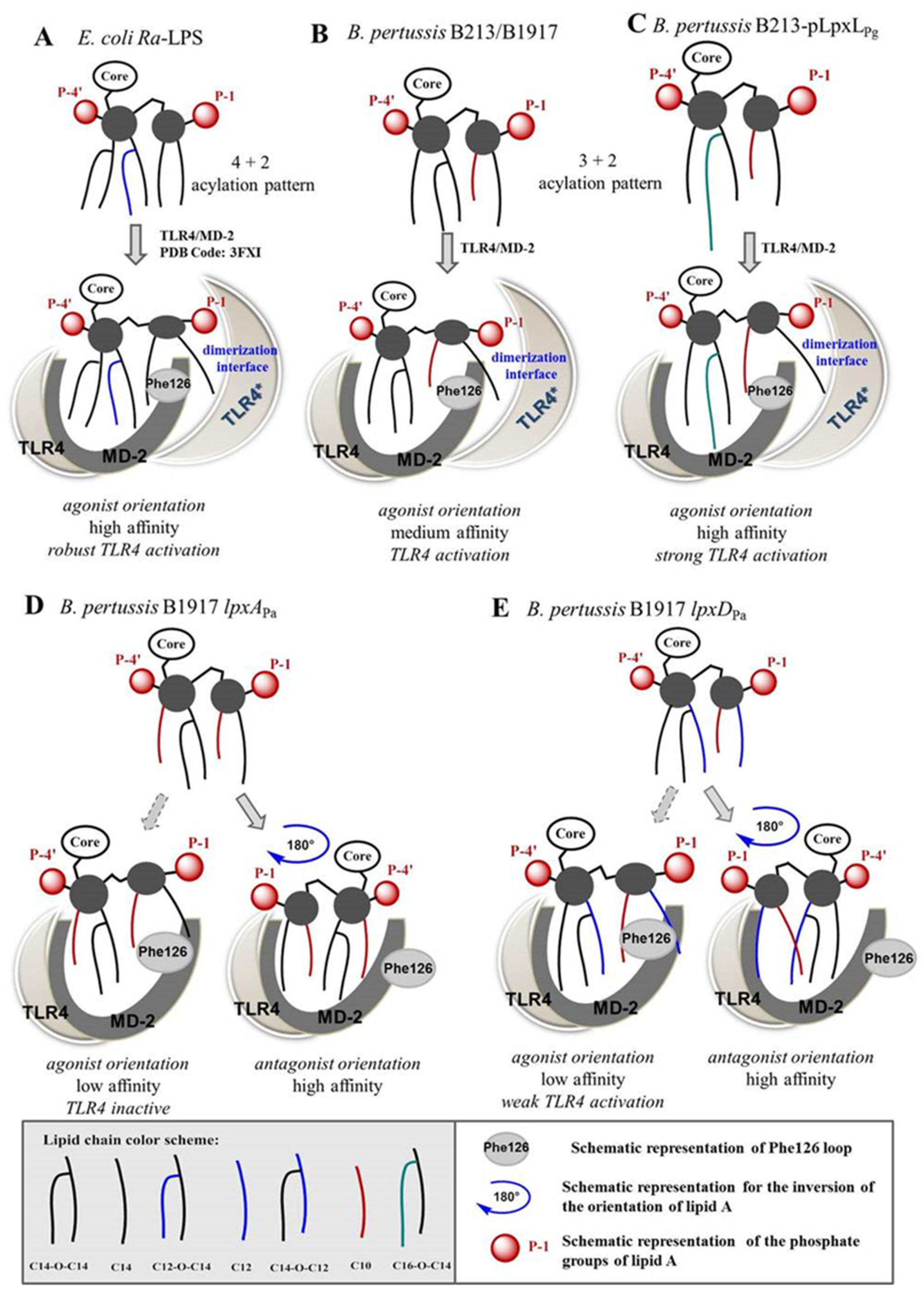
| Plasmids/Strains | Characteristics a | References |
|---|---|---|
| Plasmids | ||
| pMMB67EH | Broad host-range vector, Ptac, lacIq, AmpR | [30] |
| pKAS32 | Allele-exchange suicide vector, AmpR | [31] |
| pMMB67EH-PagLPa | pMMB67EH harboring pagL from P. aeruginosa PAO1 | [8] |
| pMMB67EH-LpxAPa | pMMB67EH harboring lpxA from P. aeruginosa PAO1 | This study |
| pMMB67EH-LpxLNm | pMMB67EH harboring lpxL1 from N. meningitidis H44/76 | This study |
| pMMB67EH-LpxLPg | pMMB67EH harboring lpxL from P. gingivalis ATCC33277 | This study |
| pMMB67EH-LpxDPa | pMMB67EH harboring lpxD from P. aeruginosa PAO1 | This study |
| pKA32-EFGH-lpxL2::gm | pKAS32 derivative harboring DNA segments of lpxL1 and downstream of lpxL2 separated by a gm cassette, AmpR, GmR | Geurtsen J |
| pKOlpxL2::gm (a) | pKA32-EFGH-lpxL2::gm derivative harboring a DNA segment upstream of lpxL1 and the entire lpxL2 gene except for the first 6 nucleotides together with a partial dap gene with, in between a gm cassette in the same orientation as the operon, AmpR, GmR | This study |
| pKOlpxL2::gm (b) | Like pKOlpxL2::gm (a) but with the gm cassette in the opposite orientation, AmpR, GmR | This study |
| pRTP113368K2a | pKAS32 derivative harboring DNA segments of lpxL2, AmpR, KanR (kan in similar orientation as the operon) | Hamstra HJ |
| pRTP113368K1a | pRTP113368K2a derivative harboring kan in opposite orientation as the operon. | Hamstra HJ |
| pRT669 | lpxA knockout construct, AmpR, KanR (kan in opposite orientation as the lpxA gene) | Hamstra HJ |
| pSS1129 | Suicide vector for allelic exchange, GmR, AmpR | [32] |
| pClpxAPa | pSS1129 derivative for replacement of lpxA gene of B. pertussis by lpxA gene of P. aeruginosa | This study |
| pClpxDPa | Construct for replacement of lpxD gene of B. pertussis by lpxA gene of P. aeruginosa | This study |
| Strains | ||
| Escherichia coli | ||
| DH5α | F−, Δ(lacZYA-argF)U169 thi-1 hsdR17 gyrA96 recA 1 endA 1 supE44 relA1 phoA Φ80 dlacZΔM15 | UU lab collection |
| SM10λpir | thi thr leu fhuA lacY supE recA::RP4–2-Tc::Mu λpir R6K KanR | [33] |
| BL21(DE3) | Contains gene for T7 DNA polymerase | Invitrogen |
| BL21-pLpxAPa | BL21(DE3) carrying pMMB67EH-LpxAPa | This study |
| BL21-pLpxLNm | BL21(DE3) carrying pMMB67EH-LpxLNm | This study |
| BL21-pLpxLPg | BL21(DE3) carrying pMMB67EH-LpxLPg | This study |
| BL21-pLpxDPa | BL21(DE3) carrying pMMB67EH-LpxDPa | This study |
| Bordetella pertussis | ||
| B213 | StrR derivative of strain Tohama I, NalR | [27] |
| B213-pLpxAPa | B213 carrying pMMB67EH-LpxAPa | This study |
| B213 ΔlpxA-pLpxAPa | B213 with inactivated lpxA gene carrying pMMB67EH-LpxAPa | This study |
| B213-pLpxLNm | B213 carrying pMMB67EH-LpxLNm | This study |
| B213-pLpxLPg | B213 carrying pMMB67EH-LpxLPg | This study |
| B213-pLpxDPa | B213 carrying pMMB67EH-LpxDPa | This study |
| B1917 | [28] | |
| B1917 lpxAPa | B1917 with lpxA gene replaced by lpxA from P. aeruginosa | This study |
| B1917 lpxDPa | B1917 with lpxD gene replaced by lpxD from P. aeruginosa | This study |
Publisher’s Note: MDPI stays neutral with regard to jurisdictional claims in published maps and institutional affiliations. |
© 2020 by the authors. Licensee MDPI, Basel, Switzerland. This article is an open access article distributed under the terms and conditions of the Creative Commons Attribution (CC BY) license (http://creativecommons.org/licenses/by/4.0/).
Share and Cite
Arenas, J.; Pupo, E.; Phielix, C.; David, D.; Zariri, A.; Zamyatina, A.; Tommassen, J.; van der Ley, P. Shortening the Lipid A Acyl Chains of Bordetella pertussis Enables Depletion of Lipopolysaccharide Endotoxic Activity. Vaccines 2020, 8, 594. https://doi.org/10.3390/vaccines8040594
Arenas J, Pupo E, Phielix C, David D, Zariri A, Zamyatina A, Tommassen J, van der Ley P. Shortening the Lipid A Acyl Chains of Bordetella pertussis Enables Depletion of Lipopolysaccharide Endotoxic Activity. Vaccines. 2020; 8(4):594. https://doi.org/10.3390/vaccines8040594
Chicago/Turabian StyleArenas, Jesús, Elder Pupo, Coen Phielix, Dionne David, Afshin Zariri, Alla Zamyatina, Jan Tommassen, and Peter van der Ley. 2020. "Shortening the Lipid A Acyl Chains of Bordetella pertussis Enables Depletion of Lipopolysaccharide Endotoxic Activity" Vaccines 8, no. 4: 594. https://doi.org/10.3390/vaccines8040594
APA StyleArenas, J., Pupo, E., Phielix, C., David, D., Zariri, A., Zamyatina, A., Tommassen, J., & van der Ley, P. (2020). Shortening the Lipid A Acyl Chains of Bordetella pertussis Enables Depletion of Lipopolysaccharide Endotoxic Activity. Vaccines, 8(4), 594. https://doi.org/10.3390/vaccines8040594




